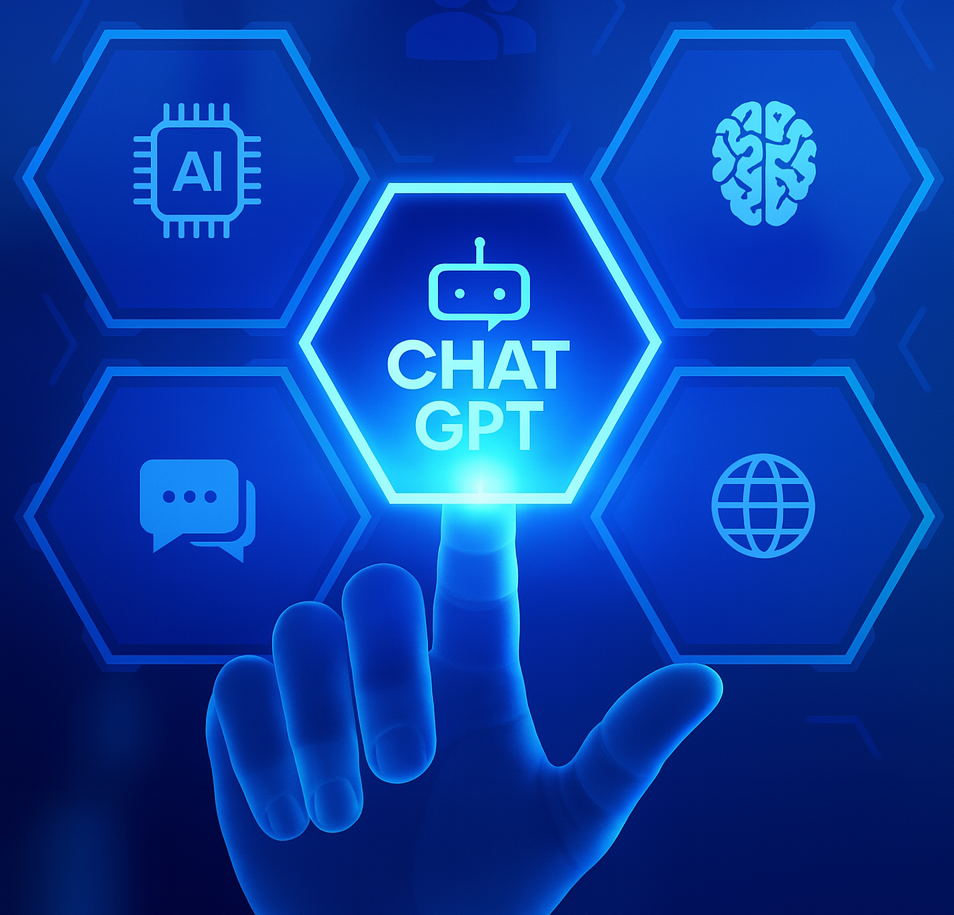
Introduction to ChatGPT
ChatGPT, developed by OpenAI, is an advanced artificial intelligence (AI) chatbot that has significantly changed how people perform research, create content, and approach problem-solving. Launched in November 2022, ChatGPT rapidly became popular due to its unique ability to understand and respond naturally to questions and instructions, making it practical and accessible for users from all backgrounds.
At its core, ChatGPT uses a technology known as Generative Pre-trained Transformer (GPT). This system is trained on extensive datasets collected from numerous internet texts, enabling it to predict and generate relevant, coherent answers. Because ChatGPT understands context effectively, it can simplify complicated topics, answer questions in detail, and even help troubleshoot issues like programming problems, acting similarly to a highly interactive, intelligent search engine.
Learning to effectively use ChatGPT is a valuable skill for everyone. Much like knowing how to search efficiently on Google, mastering how to craft precise queries to ChatGPT will significantly improve your productivity and the quality of your results.
Whether you're a student, professional, educator, or simply someone looking to enhance your knowledge or productivity, incorporating ChatGPT into your daily activities can streamline your tasks, clarify complex subjects, and help you excel in a rapidly evolving digital world.
This guide will provide you with foundational knowledge and practical strategies to confidently utilize ChatGPT across various scenarios, empowering you to thrive academically, professionally, and personally.
Understanding ChatGPT
ChatGPT operates using advanced natural language processing (NLP), which allows it to interpret and generate human-like text effectively. Behind the scenes, ChatGPT employs machine learning and deep neural networks, specifically, models known as transformers to analyze extensive data and recognize patterns. This capability enables the chatbot to deliver coherent and contextually relevant responses to users' questions or prompts.
The GPT model powering ChatGPT goes through two primary training phases:
- Pre-training:
During this phase, the model is exposed to vast and varied datasets, including books, websites, news articles, and other publicly available texts. This extensive training helps the model learn the nuances of language, including grammar, syntax, context, and general knowledge. - Fine-tuning:
After pre-training, ChatGPT is further refined to respond accurately and naturally in conversational settings. In this stage, human reviewers actively provide feedback to help the model improve the accuracy, relevance, and quality of its responses. This iterative approach significantly enhances ChatGPT’s ability to interact effectively and naturally.
However, it's crucial to recognize ChatGPT’s limitations. Due to the nature of its training data, ChatGPT can sometimes generate incorrect, outdated, or biased information. As a user, you should critically assess the AI’s responses, especially when accuracy is vital for academic, professional, or sensitive tasks.
Understanding how ChatGPT processes and generates responses empowers you to craft better, more precise prompts. This knowledge enables you to engage with the AI effectively, leading to improved accuracy and usefulness in your interactions.

How ChatGPT Works
ChatGPT functions through a deep learning model called a transformer, which is specifically designed to understand context and language nuances effectively. Transformers analyze text sequences such as sentences or paragraphs by closely examining the relationships between individual words and their meanings.
When you provide ChatGPT with a question or prompt, the model processes it by breaking down your text into smaller pieces, known as tokens. Tokens can represent entire words or just parts of words and punctuation. These tokens are then passed through multiple layers of neural networks, each responsible for capturing different aspects of language structure and meaning.
As these neural network layers interact, the model assesses relationships between words and attempts to predict the most suitable tokens to form a coherent and relevant response.
Central to this process is a sophisticated mechanism known as “attention.” This allows the model to focus selectively on the most crucial parts of your prompt, enabling it to handle complex queries, interpret detailed instructions, and generate contextually rich responses.
By understanding, even at a basic level, how ChatGPT processes language, you can significantly improve your interactions. Clear, precise, and context-rich prompts directly enhance ChatGPT’s ability to produce accurate, relevant, and valuable answers.
Step-by-Step Guide: How to Get Started
Step 1: Create an Account
Visit chat.openai.com and sign up using your email, Google, or Microsoft account. You’ll need to verify your email and possibly provide additional details depending on your choice of registration method.
Step 2: Choose Your Model
Once logged in, you can choose between different models:
- GPT-3.5: A highly capable model suitable for everyday tasks such as basic research, writing assistance, and casual interactions.
- GPT-4 & GPT-4o: More advanced options suitable for complex tasks that require deeper contextual understanding, problem-solving capabilities, or multimodal inputs (text, images, voice).
Step 3: Navigating the Interface
The ChatGPT interface is intuitive and straightforward:
- Prompt Box: This is where you'll enter your questions or commands.
- History Pane: On the left, you’ll see previous conversations that you can revisit at any time.
- Settings and Customization: Access settings to adjust preferences, manage subscriptions, and explore advanced options.
Step 4: Crafting Effective Prompts
Effective prompts are clear, concise, and specific. Begin your interaction with a detailed question or request, including relevant context to guide ChatGPT toward providing the most accurate response.
For example, instead of asking "Tell me about biology," ask "Explain the process of cellular respiration in simple terms."
Step 5: Iterative Interaction
ChatGPT excels at iterative dialogue. If the initial response isn't quite what you're looking for, refine your query or ask follow-up questions. This iterative approach allows you to clarify your needs and achieve more precise outcomes.
Using ChatGPT on Different Platforms
ChatGPT can be accessed on various platforms, each offering unique convenience:
Web Browser
The most common way to interact with ChatGPT is through the browser interface at chat.openai.com. This method works seamlessly across Windows, macOS, Linux, and any device with internet access.
iPhone
For iPhone users, the dedicated ChatGPT app is available in the App Store, providing a mobile-optimized experience. The app supports push notifications, quick interactions, and seamless integration into daily tasks.
Android
Although an official Android app may not yet be available, ChatGPT is easily accessible via any Android web browser. Simply navigate to chat.openai.com and use it in a similar fashion to the desktop version, optimized for mobile screens.
Practical Academic Uses
ChatGPT can serve as an extremely helpful tool for students, educators, and lifelong learners across various academic situations:
Writing and Essay Assistance
- Quickly create structured outlines for essays and research papers.
- Develop clear and focused thesis statements or topic sentences.
- Receive feedback on grammar, clarity, style, and readability to enhance the quality of your writing.
Study and Research Support
- Summarize long textbook chapters, academic articles, or research papers to identify key points quickly.
- Clarify difficult concepts, theories, or specialized terminology through simple, accessible explanations.
- Generate customized study guides and practice quizzes tailored to your specific coursework or subjects.
Project and Group Work
- Assist in organizing and structuring tasks for group projects, clearly defining responsibilities.
- Facilitate brainstorming sessions to spark creative and innovative ideas or solutions.
- Aid in drafting coherent presentations, reports, or collaborative documents.
Exam Preparation
- Create concise revision notes and simplified explanations for complex or challenging topics.
- Generate practice questions, quizzes, and answers tailored to various subjects and difficulty levels.
- Offer step-by-step explanations and walkthroughs for complex problems or case studies.
By strategically integrating ChatGPT into these academic activities, students and learners of all types can significantly boost their efficiency, deepen their understanding of course materials, and ultimately improve their academic performance.
Practical Professional Uses
ChatGPT is equally valuable for working professionals, offering significant advantages in various professional settings:
Professional Communication
- Draft clear, concise, and persuasive business emails, proposals, and reports.
- Develop effective presentations and meeting agendas.
- Improve clarity and professionalism in internal and external communication.
Career Development
- Optimize your resume and cover letter to enhance job application effectiveness.
- Prepare for interviews by practicing responses to common and industry-specific questions.
- Strengthen professional branding through tailored LinkedIn profile recommendations.
Technical and IT Support
- Quickly troubleshoot technical problems, from software bugs to network issues.
- Generate clear and comprehensive documentation for IT processes and systems.
- Assist in debugging code across multiple programming languages.
Content Creation and Marketing
- Produce engaging, well-structured blogs, articles, and social media content.
- Develop innovative marketing copy, advertising scripts, and promotional materials.
- Generate SEO-optimized content to improve online visibility and engagement.
Best Practices & Prompt Engineering for Effective ChatGPT Use
To effectively leverage ChatGPT, understanding prompt engineering the art of crafting precise and clear prompts is critical. Here are best practices for getting optimal responses:
Be Specific and Clear
ChatGPT generates responses based on the details provided. The clearer and more specific your instructions, the better the result. For example, instead of a vague prompt like "Write something about cybersecurity," try "Explain the fundamentals of cybersecurity threats in healthcare settings."
Provide Context
Including context helps ChatGPT generate more accurate and relevant responses. For instance, "As a nursing student studying pharmacology, can you summarize the mechanisms of action for antihypertensive drugs?"
Use Structured Prompts 
Breaking down complex requests into structured parts can enhance the AI's response. For example:
- Task: Summarize the following article.
- Focus: Key findings related to cybersecurity trends.
- Tone: Professional and concise.
Iterative Refinement
ChatGPT excels with iterative engagement. If the initial response isn't perfect, refine your prompt by asking follow-up questions or specifying further details. This incremental process improves accuracy and satisfaction.
Employ Example-based Prompts
Providing examples in your prompt clarifies expectations. For instance: "Generate a short bio similar to this format: 'John Doe is a cybersecurity analyst with over 10 years of experience...'."
Leverage System Instructions
You can begin prompts by clearly specifying the role or perspective you want ChatGPT to adopt, such as: "You are a professional career advisor. Provide advice on negotiating salary during a job offer."
Troubleshooting Common Issues
Sometimes ChatGPT may provide less-than-ideal responses. Here are common issues and solutions:
- Vague Responses: Clarify your prompt by adding specific details or context.
- Overly Detailed Answers: Instruct the AI explicitly to be concise.
- Inaccurate Information: Cross-check important details and ask for clarification or correction.
Ethical Use of ChatGPT
Using ChatGPT ethically is crucial, especially in academic and professional environments. Follow these guidelines:
- Transparency: Clearly acknowledge when ChatGPT contributes significantly to your work.
- Academic Integrity: Use ChatGPT as a supportive tool, not as a replacement for your own intellectual efforts.
- Privacy: Avoid inputting sensitive personal or confidential information into prompts.
Future Trends and Developments
AI technology, particularly models like ChatGPT, is rapidly advancing and will continue to offer enhanced capabilities, making interactions even more intuitive and powerful. Some key developments expected include:
Improved Accuracy and Reliability
Future iterations of ChatGPT are expected to become increasingly accurate and context-aware, producing more reliable and precise responses, reducing errors, and enhancing user trust.
Multimodal Interaction
Advancements will enable ChatGPT to process multiple types of inputs such as images, audio, and video in addition to text, allowing richer and more versatile interactions across different forms of media.
Integration with Other Technologies
ChatGPT is likely to become more seamlessly integrated into educational platforms (such as Learning Management Systems), productivity tools, and business applications, creating smoother workflows and increased productivity for users.
By staying informed about these trends and continuously improving how you interact with AI tools like ChatGPT, you can remain at the forefront of innovation, making the most of these powerful advancements in your academic, professional, and personal endeavors.

